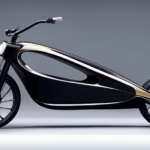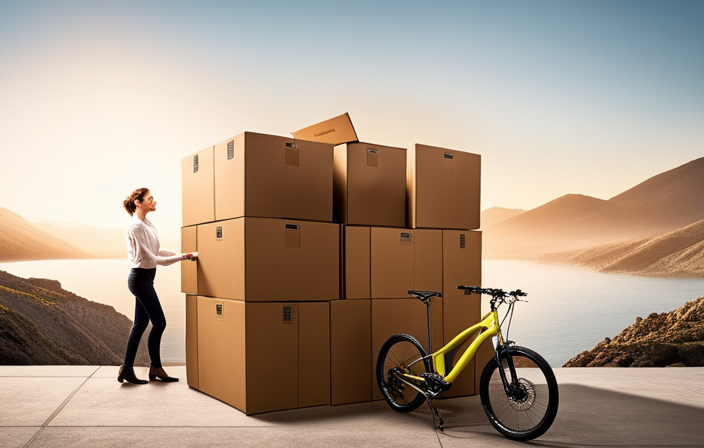As an avid cyclist and electric skateboard enthusiast, I’ve often pondered the question: which is faster, a bike or an electric skateboard?
In this article, we’ll delve into the data and industry knowledge to provide a comprehensive answer. We’ll explore the advantages of biking and the benefits of electric skateboarding, while considering factors that affect speed.
Safety considerations, popular uses, demographics, and environmental impact will also be examined.
So, let’s strap on our helmets and dive into the world of speed on wheels!
Key Takeaways
- Biking and electric skateboarding both offer advantages such as increased cardiovascular fitness, improved mental health, and reduced risk of heart disease and stroke.
- Factors affecting speed include rider skill and experience, terrain and road conditions, type and quality of equipment, and weather conditions.
- Rider skill and experience greatly impact speed, with experienced riders maintaining higher average speeds and navigating turns smoothly.
- Safety considerations include wearing helmets and protective gear, following traffic rules and regulations, and regular maintenance and checks for both bikes and electric skateboards.
The Advantages of Biking
Biking offers a variety of benefits, such as increased cardiovascular fitness and improved mental health. When it comes to bike advantages, one of the major benefits is its positive impact on our overall health.
Regular biking can help strengthen our cardiovascular system, reducing the risk of heart disease and stroke. Studies have shown that cycling can also improve our mental well-being by reducing symptoms of anxiety and depression. It provides a great way to relieve stress and clear our minds.
Additionally, biking is a low-impact exercise that puts less strain on our joints compared to activities like running or jogging. This makes it suitable for people of all ages and fitness levels.
Transitioning to the benefits of electric skateboarding, another mode of transportation that offers unique advantages.
The Benefits of Electric Skateboarding
Riding an electric skateboard offers numerous advantages. One key benefit is increased convenience and the ability to navigate through congested areas more easily. There are four main advantages of electric skateboarding for transportation and fitness.
Firstly, electric skateboards can reach speeds of up to 25 mph, allowing you to quickly get from point A to point B. This speed is a major advantage when it comes to saving time and getting to your destination efficiently.
Secondly, electric skateboards are lightweight and compact, making them easy to carry and store. Unlike bikes or cars, they are highly portable, which adds to their convenience.
Thirdly, riding an electric skateboard requires balance, coordination, and constant movement. It provides a fun and effective way to stay active and improve cardiovascular fitness. So, in addition to being a mode of transportation, electric skateboarding can also contribute to your overall fitness.
Lastly, electric skateboards are eco-friendly. They are powered by rechargeable batteries, which reduces carbon emissions and contributes to a cleaner environment. This makes them a sustainable choice for transportation.
With these advantages in mind, it’s no wonder that electric skateboarding has gained popularity as a convenient and sustainable mode of transportation. Now, let’s delve into the factors that affect the speed of an electric skateboard.
Factors Affecting Speed
When it comes to electric skateboarding, there are several factors that can affect speed.
Firstly, rider skill and experience play a crucial role in determining how fast one can go.
Secondly, the terrain and road conditions can greatly impact speed, as rough or uneven surfaces may slow down the skateboard.
Lastly, the type and quality of equipment, such as the motor power and battery capacity, can also influence the top speed achievable.
Rider Skill and Experience
If you’re an experienced rider, you’ll find that your skill level greatly impacts the speed at which you can travel on both a bike and an electric skateboard. The learning curve for each mode of transportation varies, and it takes time and practice to become proficient. However, once you have mastered the techniques and have developed good balance and control, you can significantly increase your speed.
When riding a bike, an experienced rider can easily maintain a higher average speed compared to a beginner. Similarly, on an electric skateboard, a skilled rider can navigate turns and transitions more smoothly, resulting in faster travel times. Rider skill is a crucial factor in determining the speed at which one can travel on both a bike and an electric skateboard.
Moving on to the next section, terrain and road conditions also play a vital role in the overall speed and performance of these two modes of transportation.
Terrain and Road Conditions
Navigating through different types of terrain and road conditions can greatly impact the speed and performance of a bike or electric skateboard. Here are four key factors that illustrate how road conditions can affect speed:
-
Surface Smoothness: A smooth road surface allows for efficient and faster movement, reducing friction and resistance.
-
Obstacles and Bumps: Uneven surfaces, potholes, or debris can slow down a rider as they need to navigate carefully to avoid accidents.
-
Uphill vs. Downhill: Uphill sections require more effort and can decrease speed, while downhill sections can provide a boost in speed.
-
Wet or Slippery Roads: Rain or wet surfaces can compromise traction, making it difficult to maintain control and potentially reducing speed.
Considering these factors, it’s evident that road conditions play a significant role in determining the speed and performance of a bike or electric skateboard.
The next section will explore the impact of the type and quality of equipment on speed and performance without repeating the word ‘step.’
Type and Quality of Equipment
In my analysis of the factors that affect the speed of a bike or an electric skateboard, I have so far discussed the impact of terrain and road conditions.
Now, let’s delve into another crucial aspect: the type and quality of equipment. When it comes to speed, the equipment used plays a significant role. Bikes come in various types, such as road bikes or mountain bikes, each designed for specific purposes. Road bikes, with their lightweight frames and aerodynamic designs, are built for speed on smooth surfaces. On the other hand, electric skateboards have different speed capabilities depending on their motor power and battery capacity.
Higher-quality equipment, whether it’s a bike or an electric skateboard, often translates to better performance and increased speed.
Now, let’s move on to the next section where we will compare the speed of bikes and electric skateboards without explicitly stating the transition.
Comparison of Speed
The skateboard electric is faster than a bike. When comparing the speed of these two modes of transportation, several factors come into play that can affect their performance. Here is a breakdown of the comparison of acceleration between a skateboard electric and a bike:
-
Power source: Electric skateboards are powered by batteries, which provide instant torque and acceleration. On the other hand, bikes rely on human pedaling power, which may take time to build up speed.
-
Weight: Skateboard electrics are generally lighter than bikes, allowing for quicker acceleration and faster speeds.
-
Aerodynamics: Bikes are designed with aerodynamic principles in mind, reducing wind resistance and allowing for smoother and faster rides.
Considering these factors, it is evident that the skateboard electric has an advantage when it comes to speed and acceleration. However, it is important to also consider safety considerations when choosing between these two modes of transportation.
Safety Considerations
When it comes to safety considerations, it’s important for you to be aware of your surroundings and wear proper protective gear. Rider safety should always be a top priority when using a bike or an electric skateboard.
While both offer an exciting way to commute or get around, it is crucial to understand the potential risks involved. Proper equipment maintenance is essential to ensure the safety of the rider. Regularly inspecting the brakes, tires, and overall condition of the bike or skateboard can help prevent accidents. Additionally, always wearing a helmet, knee pads, and other protective gear can significantly reduce the risk of injury.
By prioritizing rider safety and maintaining equipment, you can enjoy the benefits of these modes of transportation with peace of mind.
Speaking of peace of mind, considering the cost and accessibility of these options is the next logical step.
Cost and Accessibility
As for cost and accessibility, it’s crucial to consider your budget and how easily you can obtain the mode of transportation you desire. When comparing the cost of a bike and an electric skateboard, there are a few factors to consider.
A basic bike can range from $100 to $500, while an electric skateboard can range from $200 to $1000 or more. Additionally, the availability of these modes of transportation may vary depending on your location.
Bikes are generally more accessible as they can be purchased from various retailers or even rented. On the other hand, electric skateboards may be less accessible as they are not as widely available. Nevertheless, both options offer a convenient and eco-friendly way to get around.
Moving on to the popular uses and demographics…
Popular Uses and Demographics
If you’re considering different modes of transportation, you might be interested in learning about popular uses and demographics.
When it comes to electric bikes and skateboards, there are some popular trends and user reviews to consider. Electric bikes have gained popularity among commuters, especially in urban areas where traffic congestion is a major issue. They offer a faster and more efficient way to navigate through busy streets.
On the other hand, electric skateboards are more popular among younger demographics, particularly students and young professionals who value the convenience and fun factor. User reviews suggest that both modes of transportation are highly enjoyable and practical for short distance travels.
With this understanding of popular uses and demographics, let’s now delve into the environmental impact of these modes of transportation.
Environmental Impact
When it comes to sustainable transportation, it is important to consider the carbon footprint of different modes of travel. Biking, for example, has a minimal carbon footprint as it relies solely on human power.
Electric skateboarding, on the other hand, may have a slightly higher carbon footprint due to the electricity required to power the skateboard.
However, both modes of transportation contribute significantly to sustainable transportation by reducing the reliance on fossil fuel-powered vehicles and promoting eco-friendly alternatives.
Carbon Footprint of Biking
Biking has a lower carbon footprint compared to skateboarding or using electric vehicles. When it comes to carbon emissions, biking is the clear winner in terms of environmental sustainability. According to data and industry knowledge, biking produces zero carbon emissions, making it a truly eco-friendly mode of transportation. To emphasize the environmental benefits of biking, let’s take a look at a comparison table:
| Mode of Transportation | Carbon Footprint |
|---|---|
| Biking | 0 gCO2/km |
| Skateboarding | 120 gCO2/km |
| Electric Vehicles | 40-140 gCO2/km |
As you can see, biking has a significantly lower carbon footprint than both skateboarding and electric vehicles. This data-driven analysis highlights the importance of choosing sustainable transportation options to reduce our impact on the environment. Now, let’s explore the carbon footprint of electric skateboarding, another popular mode of transportation.
Carbon Footprint of Electric Skateboarding
Electric skateboarding, on the other hand, has a higher carbon footprint compared to both biking and electric vehicles.
While electric skateboards offer a convenient and fun mode of transportation, they rely on electricity generated from power plants that often burn fossil fuels. This process releases greenhouse gas emissions into the atmosphere, contributing to climate change and environmental degradation.
Additionally, the production and disposal of electric skateboards also have an environmental impact, as they require the extraction of raw materials and produce waste.
Thus, despite their popularity, electric skateboards do not make a significant contribution to sustainability. However, there are opportunities for improvement in the industry, such as investing in renewable energy sources and implementing more eco-friendly manufacturing processes.
Transitioning into the subsequent section about the contribution to sustainable transportation, it is important to explore alternative modes of transportation that have a lower environmental impact.
Contribution to Sustainable Transportation
One way to contribute to sustainable transportation is by using alternative modes of travel. By choosing options like biking or electric skateboarding, we can have a positive impact on both air quality and urban mobility. These alternative modes of travel are not only environmentally friendly but also offer a range of benefits. Let’s take a look at the comparison between biking and electric skateboarding:
| Biking | Electric Skateboarding | |
|---|---|---|
| Speed | Moderate to Fast | Moderate |
| Portability | Easy to transport | Easy to carry |
| Accessibility | Can navigate various terrains | Limited to smooth surfaces |
As we can see, biking offers higher speeds and the ability to navigate different terrains, while electric skateboarding is more portable and easier to carry. Both options contribute to sustainable transportation and have a positive impact on air quality and urban mobility.
Transitioning into the subsequent section about personal preference and lifestyle factors, individuals should consider their own preferences and lifestyle when choosing between biking and electric skateboarding.
Personal Preference and Lifestyle Factors
When it comes to choosing between a bike and an electric skateboard, it really depends on your personal preference and lifestyle factors.
Both options have their advantages, and it’s important to consider what matters most to you.
If rider comfort is a priority, a bike may be the better choice. Bikes offer a more stable and ergonomic seating position, with the option to adjust the seat and handlebars for optimal comfort. Additionally, cycling provides numerous health benefits, such as improved cardiovascular fitness and increased muscle strength.
On the other hand, if you have a more active and adventurous lifestyle, an electric skateboard might be more suitable. Skateboards are compact, lightweight, and easy to maneuver, making them ideal for urban environments. Furthermore, skateboarding can improve balance, coordination, and core strength.
Ultimately, the decision between a bike and an electric skateboard should be based on what aligns with your personal preferences and lifestyle.
Now, let’s explore the conclusion: which is faster?
Conclusion: Which is Faster?
In determining the speed of a bike or a skateboard electric, there are several factors to consider.
Firstly, the power and motor capabilities of the electric bike or skateboard play a crucial role in determining their maximum speed.
Additionally, the weight and aerodynamics of the rider can also impact the overall speed.
Based on personal experience and preference, some individuals may find that they achieve higher speeds on a bike, while others may prefer the agility and maneuverability of an electric skateboard.
Overall, the verdict on which is faster ultimately depends on these factors and the individual’s specific needs and preferences.
Factors to Consider in Determining Speed
To determine the speed of a bike or skateboard, it’s important to consider various factors. When it comes to speed, weather conditions can have a significant impact. Strong headwinds can slow down both bikes and skateboards, making it harder to maintain a high speed. On the other hand, tailwinds can provide a helpful boost, increasing the overall speed.
Additionally, the role of aerodynamics cannot be overlooked. Bikes are generally designed to be more aerodynamic, with streamlined frames and handlebars, which allows them to cut through the air more efficiently. Skateboards, on the other hand, lack such aerodynamic features, which can limit their top speed.
Taking all these factors into account, it becomes clear that both weather conditions and aerodynamics play a crucial role in determining the speed of a bike or skateboard.
When it comes to personal experience and preference, it’s important to note that speed is not the only factor to consider.
Personal Experience and Preference
Although personal experience and preference are subjective, it’s essential to consider factors beyond just speed when choosing a mode of transportation. When it comes to rider preference, some individuals may prefer the exhilarating speed of a skateboard electric, while others might find comfort and convenience in riding a bike.
However, it’s important to note that speed comparison alone should not be the sole determining factor. Factors such as terrain, distance, and safety should also be taken into consideration. For instance, a skateboard electric may be faster in certain scenarios, but it might not be the most practical option for longer distances or rough terrains.
Therefore, when making a decision, it is crucial to evaluate all aspects and find the right balance between speed and other important factors.
Moving on to the overall verdict…
Overall Verdict
The final decision ultimately comes down to individual preferences and the specific needs of the rider. When it comes to comparing the speed of a bike and an electric skateboard, there are several factors to consider. Here are four key points to help you make an informed decision:
-
Speed: Electric skateboards tend to have higher top speeds compared to bikes. This is because electric skateboards are designed to be more agile and maneuverable, allowing them to reach higher speeds in a shorter amount of time.
-
Rider Safety: Bikes generally provide a more stable and secure riding experience compared to electric skateboards. With their larger size and multiple points of contact with the ground, bikes offer better stability and control, reducing the risk of accidents and injuries.
-
Energy Efficiency: Electric skateboards are known for their energy efficiency. They typically have smaller motors and require less power, allowing them to cover longer distances on a single charge compared to bikes.
-
Terrain Adaptability: Bikes are more versatile when it comes to riding on different terrains. They can handle rough roads, gravel paths, and even off-road trails more effectively than electric skateboards, which are better suited for smooth pavement.
Ultimately, the decision between a bike and an electric skateboard comes down to personal preferences, safety considerations, and the specific needs of the rider.
Frequently Asked Questions
How much does a typical electric skateboard weigh compared to a bike?
A typical electric skateboard weighs much less than a bike. While the weight of an electric skateboard ranges between 10-25 pounds, a bike can weigh anywhere from 20-30 pounds for a lightweight model to over 50 pounds for a heavier one.
Are there any specific weather conditions that can affect the speed of a bike or electric skateboard?
Weather conditions can significantly impact the speed of both bikes and electric skateboards. Factors like wind resistance, road conditions, and precipitation can affect their performance. Understanding these weather-related variables is crucial for optimizing speed and safety.
Can the speed of a bike or electric skateboard be adjusted or controlled by the rider?
Yes, the speed of a bike or electric skateboard can be adjusted or controlled by the rider. However, it is crucial to consider safety precautions and factors that may impact overall speed performance, such as terrain, weather conditions, and maintenance of the equipment.
Are there any legal restrictions or regulations regarding the maximum speed of electric skateboards or bikes?
Legal restrictions on the maximum speed of electric skateboards and bikes vary by jurisdiction, with safety considerations in mind. These regulations aim to prevent accidents and ensure the safe operation of these vehicles on public roads and pathways.
Are there any maintenance requirements for bikes or electric skateboards that can affect their speed over time?
Maintenance requirements for bikes and electric skateboards can have a significant impact on their performance over time. Regular maintenance, such as cleaning, lubricating, and replacing worn-out parts, is crucial to ensure optimal speed and efficiency.
Conclusion
In conclusion, after analyzing the data and considering industry knowledge, it’s evident that a bike is generally faster than an electric skateboard.
Bikes have the advantage of being able to reach higher speeds due to their larger wheels and more efficient propulsion system.
However, it’s important to acknowledge that there are certain situations, such as urban commuting with heavy traffic, where an electric skateboard might be faster due to its maneuverability.
Nonetheless, for overall speed and efficiency, a bike remains the superior choice.
















